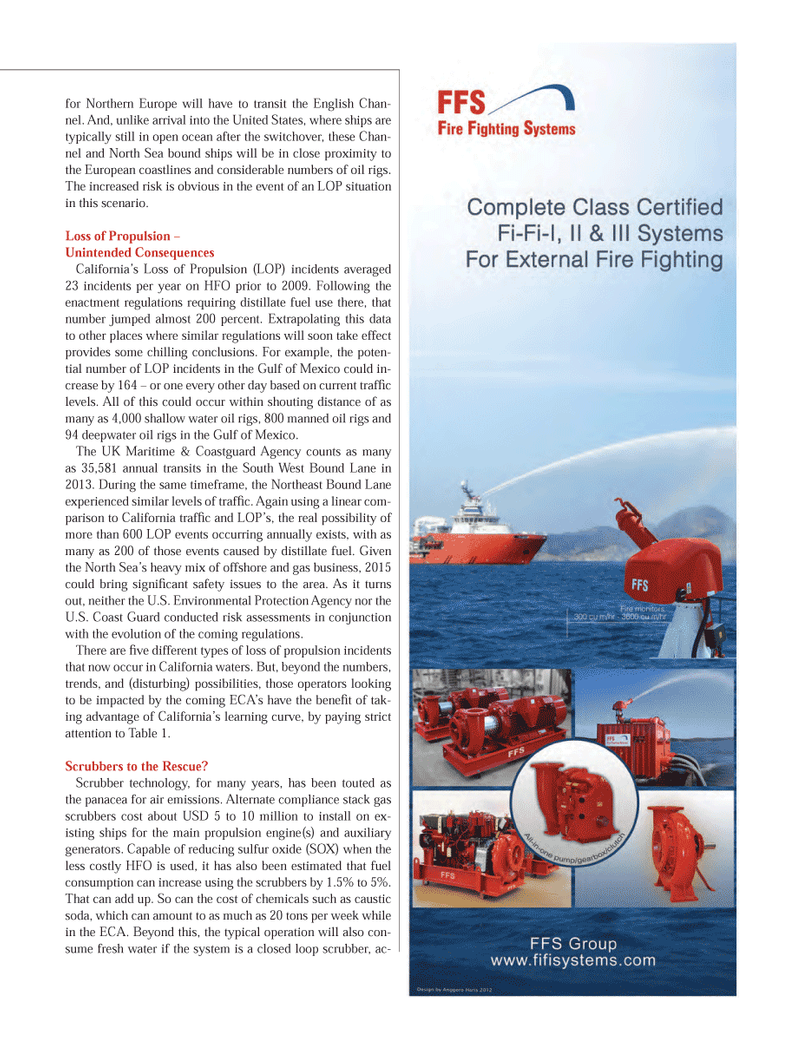
Page 21: of Maritime Logistics Professional Magazine (Q3 2014)
Power & Fuel Management
Read this page in Pdf, Flash or Html5 edition of Q3 2014 Maritime Logistics Professional Magazine
for Northern Europe will have to transit the English Chan- nel. And, unlike arrival into the United States, where ships are typically still in open ocean after the switchover, these Chan- nel and North Sea bound ships will be in close proximity to the European coastlines and considerable numbers of oil rigs. The increased risk is obvious in the event of an LOP situation in this scenario. Loss of Propulsion ? Unintended ConsequencesCalifornia?s Loss of Propulsion (LOP) incidents averaged 23 incidents per year on HFO prior to 2009. Following the enactment regulations requiring distillate fuel use there, that number jumped almost 200 percent. Extrapolating this data to other places where similar regulations will soon take effect provides some chilling conclusions. For example, the poten- tial number of LOP incidents in the Gulf of Mexico could in- crease by 164 ? or one every other day based on current traf c levels. All of this could occur within shouting distance of as many as 4,000 shallow water oil rigs, 800 manned oil rigs and 94 deepwater oil rigs in the Gulf of Mexico. The UK Maritime & Coastguard Agency counts as many as 35,581 annual transits in the South West Bound Lane in 2013. During the same timeframe, the Northeast Bound Lane experienced similar levels of traf c. Again using a linear com- parison to California traf c and LOP?s, the real possibility of more than 600 LOP events occurring annually exists, with as many as 200 of those events caused by distillate fuel. Given the North Sea?s heavy mix of offshore and gas business, 2015 could bring signi cant safety issues to the area. As it turns out, neither the U.S. Environmental Protection Agency nor the U.S. Coast Guard conducted risk assessments in conjunction with the evolution of the coming regulations. There are ve different types of loss of propulsion incidents that now occur in California waters. But, beyond the numbers, trends, and (disturbing) possibilities, those operators looking to be impacted by the coming ECA?s have the bene t of tak- ing advantage of California?s learning curve, by paying strict attention to Table 1. Scrubbers to the Rescue? Scrubber technology, for many years, has been touted as the panacea for air emissions. Alternate compliance stack gas scrubbers cost about USD 5 to 10 million to install on ex- isting ships for the main propulsion engine(s) and auxiliary generators. Capable of reducing sulfur oxide (SOX) when the less costly HFO is used, it has also been estimated that fuel consumption can increase using the scrubbers by 1.5% to 5%. That can add up. So can the cost of chemicals such as caustic soda, which can amount to as much as 20 tons per week while in the ECA. Beyond this, the typical operation will also con- sume fresh water if the system is a closed loop scrubber, ac- 18-33 Q3 MP2014.indd 2118-33 Q3 MP2014.indd 218/13/2014 3:33:26 PM8/13/2014 3:33:26 PM

 20
20

 22
22
